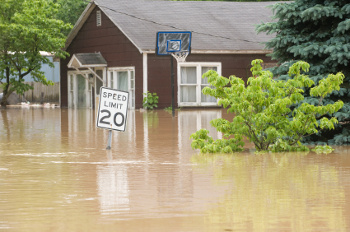
As New England mops up and tallies damages from a record-breaking mid-March storm, New Jersey is bracing for continued flooding, and the Dakotas, Minnesota, and Iowa are sandbagging. North Dakota’s flood-prone Red River crested at 37 feet in Fargo over the spring equinox weekend, a few feet short of its record. Heavy spring rains on top of melting snowpack and saturated soils pose a high flood risk across the upper Midwest, East, and South. According to the National Oceanic and Atmospheric Administration, one-third of the continental United States is at above-average risk for floods this spring.
As this interactive flooding history map shows, almost every state in the nation has experienced some degree of major flooding since the early 1990s. The West Coast’s rainy season (November to April) brings soaking rain to many parts of California (though much of the West is at low risk this season). Monsoon thunderstorms crash through Arizona in July, while coastal states watch for summer hurricanes. Even in low-risk areas, new construction projects, which pave over rain-absorbent land, can cause flooding.
Floodwaters can be deceptively deep and fast-moving—and they can kill. They’re much more likely to destroy property than lives, though. The odds that a person will be killed in a year by a flash flood (a sudden, intense flow) are 1 in 4,618,000, and the odds that a person will die in a river flood in a year are 1 in 16,920,000. In contrast, the odds that a premium dollar of home insurance will be used to pay water damage claims are 1 in 10.
Standard homeowners’ insurance policies don’t even cover flood damage. In designated “special flood hazard areas,” the National Flood Insurance Program (NFIP) has calculated that the odds of flooding are at least 1 in 100 in any given year, which translates to 1 in 3.84 odds during a 30-year mortgage. To obtain mortgages from federally regulated or insured lenders, homes and businesses in these areas are required to have flood insurance. People in NFIP communities, where local government is required to pass ordinances that reduce flooding risks, can buy special flood insurance backed by the federal government.
But outside these areas, many homeowners go without; flood insurance can be costly. Of course, so can not having it. Anyone who’s had to pump out their basement, replace their hot water heater, and buy new, taller shelves can tell you that.